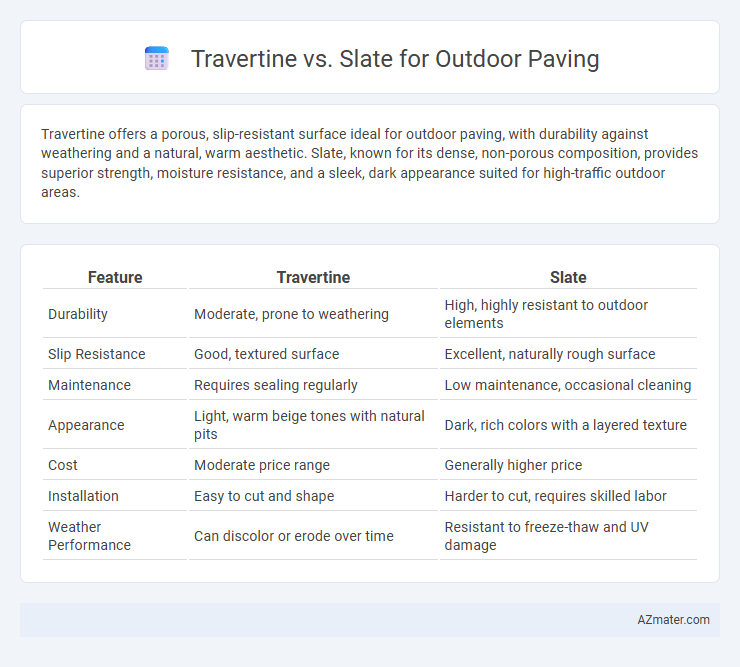Travertine offers a porous, slip-resistant surface ideal for outdoor paving, with durability against weathering and a natural, warm aesthetic. Slate, known for its dense, non-porous composition, provides superior strength, moisture resistance, and a sleek, dark appearance suited for high-traffic outdoor areas.
Table of Comparison
| Feature | Travertine | Slate |
|---|---|---|
| Durability | Moderate, prone to weathering | High, highly resistant to outdoor elements |
| Slip Resistance | Good, textured surface | Excellent, naturally rough surface |
| Maintenance | Requires sealing regularly | Low maintenance, occasional cleaning |
| Appearance | Light, warm beige tones with natural pits | Dark, rich colors with a layered texture |
| Cost | Moderate price range | Generally higher price |
| Installation | Easy to cut and shape | Harder to cut, requires skilled labor |
| Weather Performance | Can discolor or erode over time | Resistant to freeze-thaw and UV damage |
Introduction to Travertine and Slate for Outdoor Paving
Travertine pavers, a form of natural limestone, are prized for their distinctive porous texture and warm earth tones, offering slip resistance and durability in outdoor paving. Slate, a metamorphic rock, features a smooth yet textured surface with rich color variations, providing strength and weather resistance ideal for patios and walkways. Both materials balance aesthetic appeal with functionality, making them popular choices for enhancing outdoor spaces.
Key Characteristics of Travertine Pavers
Travertine pavers feature a porous surface with natural anti-slip properties, making them ideal for outdoor paving in wet conditions. Their ability to retain coolness underfoot, even in hot climates, enhances comfort around pools and patios. Durable and resistant to cracking, travertine offers long-lasting performance combined with a timeless, elegant appearance.
Key Characteristics of Slate Pavers
Slate pavers offer exceptional durability, natural slip resistance, and a unique textured surface ideal for outdoor paving. Their dense, fine-grained composition provides enhanced weather resistance, making them suitable for various climates and heavy foot traffic. Slate also features a rich color palette with earthy tones that complement outdoor landscapes while requiring minimal maintenance.
Durability and Longevity Comparison
Travertine offers excellent durability with natural resistance to cracking and weathering, making it ideal for outdoor paving in moderate climates. Slate is highly durable, featuring superior hardness and resistance to freeze-thaw cycles, which enhances its longevity in colder or wetter environments. Choosing between travertine and slate hinges on specific outdoor conditions, with slate generally providing longer-lasting performance in harsher weather.
Slip Resistance and Safety Considerations
Travertine offers excellent slip resistance for outdoor paving due to its naturally textured surface and porous composition, making it a safer option in wet conditions. Slate, while visually appealing with its smooth, layered appearance, can become slippery when wet unless treated with anti-slip coatings or textured finishes. Safety considerations favor travertine for areas prone to moisture, but slate's durability and slip resistance can be enhanced through proper surface treatments.
Weather Resistance and Climate Suitability
Travertine offers excellent weather resistance with natural porosity that allows for breathability and heat retention, making it ideal for hot, dry climates and regions with mild winters. Slate provides superior durability against frost and moisture due to its dense, non-porous structure, better suited for colder, wetter climates prone to freezing and thawing cycles. Selecting between travertine and slate for outdoor paving should consider local climate conditions to ensure longevity and performance under specific weather stresses.
Aesthetic Appeal and Design Versatility
Travertine offers a warm, natural stone aesthetic with creamy beige tones and a porous texture that creates a classic Mediterranean look, making it ideal for elegant outdoor paving designs. Slate provides a sleek, contemporary appearance with its rich, deep grays and blues, featuring a smooth yet textured surface that enhances modern and rustic outdoor spaces alike. Both materials exhibit exceptional design versatility, allowing customization through various cuts and finishes to complement diverse landscape styles and architectural settings.
Installation Process and Maintenance Requirements
Travertine offers a straightforward installation process due to its uniform thickness and natural slip resistance, making it ideal for outdoor paving projects that require quick, efficient setups. Slate requires meticulous preparation and skilled labor because of its variable thickness and cleft texture, which can complicate leveling and bonding during installation. Maintenance for travertine involves regular sealing to protect against stains and weathering, whereas slate demands more frequent cleaning and occasional sealing to maintain its durability and appearance in outdoor environments.
Cost Comparison: Travertine vs Slate
Travertine outdoor paving typically ranges from $15 to $30 per square foot, offering a mid-range cost option compared to slate, which usually costs between $25 and $50 per square foot due to its density and durability. Installation expenses for travertine tend to be lower because of its lighter weight and ease of cutting, whereas slate's hardness can increase labor costs. Overall, travertine provides a more budget-friendly solution for paving projects, while slate commands a premium price reflecting its long-term resilience and unique texture.
Choosing the Right Stone for Your Outdoor Space
Travertine offers a natural, porous texture with excellent heat resistance, making it ideal for outdoor paving in warm climates. Slate provides superior durability and a slip-resistant surface, suitable for areas with heavy foot traffic and wet conditions. Selecting between travertine and slate depends on your climate, desired aesthetic, and maintenance preferences to ensure long-lasting outdoor flooring.

Infographic: Travertine vs Slate for Outdoor Paving
 azmater.com
azmater.com